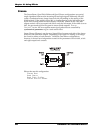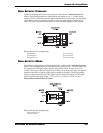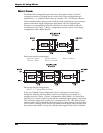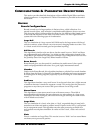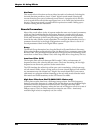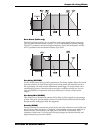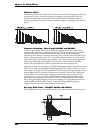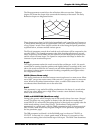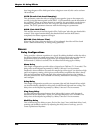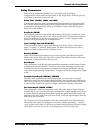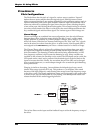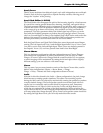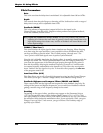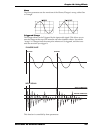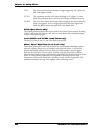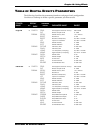
Chapter 10: Using Effects
220 ANDROMEDA A6 REFERENCE MANUAL
how long the gate will be held open before it begins to turn off; this can be set from
100 to 600 ms.
GATE (Reverb Gate Level Damping)
This parameter creates the effect of plugging an expander/gate on the output of a
reverb, giving the famous gated reverb effect. GATE essentially sets the threshold of
the expander. When set to zero, there is no cutoff by the gate and the reverb decays
normally; higher values of GATE will "chop off" the reverb at earlier and earlier
points. The GATE parameter interacts with the following two parameters:
HOLD (Gate Hold Time)
This sets the amount of time the signal will be "held open" after the gate threshold is
crossed. If the signal remains below the threshold level and the hold time is
completed, the release segment will begin:
RELEAS (Gate Release Time)
When the gate closes, this sets the curve of how abruptly the effect will be closed
down: almost immediately, or fading away gradually.
DELAYS
Delay Configurations
Delay provides a discrete repetition of a signal. By adding feedback within the effect,
the delayed signal can repeat many times, with each successive decay softer than its
predecessor. Each of the Delay types allow you to adjust their delay time in
milliseconds (1/1000 of a second). The A6 offers the following types of delay:
Mono Delay
This Single configuration provides delay of signal up to 5499 ms (5 1/2 seconds). The
delay time can be adjusted separately by 100ms, 10ms and 1 ms increments.
Feedback is also available to increase the complexity of the signal. You also have high
and low frequency cutting, which gives you the ability to equalize the effect’s decay.
This can help emulate an old tape-style echo where each succesive echo is darker
than the previous one. Also available are Density, Modulation (chorusing), Tremolo
and Autopan.
Delay:Delay
This Single configuration provides two separate right and left channel delays which
can be individually adjusted for delay time, feedback and high and low cutting. The
delay time can be adjusted separately by 100ms, 10ms and 1 ms increments.
Ping Pong Delay
So called because the output bounces from left to right in stereo with the speed
determined by the delay time. Again, low and high frequency cut is available. The
delay time can be adjusted separately by 100ms, 10ms and 1 ms increments.
MultiTap Delay
This is like having five delays at once. Each of the “taps” have individual delay, level,
panning and feedback controls. By adjusting the delay time of each tap, you can
create sophisticated rhythms.



